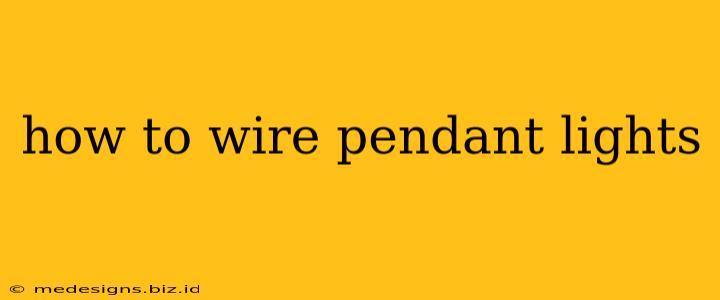Hanging pendant lights can dramatically transform a room's ambiance, adding style and functionality. But before you can enjoy the warm glow, you need to know how to wire them correctly and safely. This comprehensive guide will walk you through the process, step-by-step, ensuring a successful installation. Safety is paramount, so if you're uncomfortable working with electricity, always consult a qualified electrician.
Essential Tools and Materials
Before you begin, gather the necessary tools and materials. Having everything ready will streamline the process and prevent delays. You'll need:
- Your pendant light fixture: Make sure you have all the components, including the canopy, downrod (if applicable), and wiring.
- Voltage tester: This is crucial for ensuring power is off and preventing electrical shocks.
- Wire strippers/cutters: To safely prepare the wires for connection.
- Wire connectors (wire nuts): To securely join the wires. Use appropriately sized wire nuts for the gauge of wire you're working with.
- Screwdrivers (Phillips and flathead): For securing the fixture and canopy.
- Pliers (needle-nose are helpful): For manipulating wires and tightening connections.
- Level: To ensure the fixture hangs straight.
- Electrical tape (optional): For added insulation, although wire nuts generally provide sufficient insulation.
- Ladder or step stool: To safely reach the ceiling.
Step-by-Step Wiring Instructions
1. Turn Off the Power: This is the most crucial step. Locate the circuit breaker controlling the ceiling light and switch it OFF. Double-check with your voltage tester to ensure the power is completely off at the junction box.
2. Access the Junction Box: Carefully remove the existing light fixture (if there is one). Take note of how the wires are connected—this will be helpful as a reference later.
3. Prepare the Wires: Strip about ½ inch of insulation from the ends of both the house wires and the pendant light wires. Be careful not to nick the copper wire itself.
4. Connect the Wires: Most pendant lights use three wires:
- Black (hot): Connect the black wire from the house to the black wire from the pendant light using a wire nut.
- White (neutral): Connect the white wire from the house to the white wire from the pendant light using a wire nut.
- Ground (bare copper or green): Connect the ground wire from the house to the ground wire from the pendant light using a wire nut. Make sure the connections are tight and secure.
Important Note: If your house wiring includes a ground wire, do not omit connecting the ground wire. A properly grounded fixture prevents electrical shock.
5. Secure the Wires: Tuck the wire nuts and wires neatly into the junction box. Avoid overcrowding the box.
6. Mount the Fixture: Carefully attach the canopy and the pendant light fixture to the electrical box according to the manufacturer's instructions. Make sure everything is securely fastened.
7. Install the Shade and Bulb: Once the fixture is securely mounted, install the shade and bulb.
8. Turn the Power Back On: Carefully switch the circuit breaker back ON. Test the pendant light to ensure it is functioning correctly.
Troubleshooting Common Problems
- Light doesn't turn on: Recheck all wire connections. Ensure the circuit breaker is on and the bulb is working.
- Flickering light: This could indicate a loose connection or a faulty bulb. Check the connections and try a new bulb.
- Fixture is not level: Use a level to ensure the fixture is properly aligned before securing it.
Choosing the Right Pendant Light
Selecting the right pendant light involves considering several factors:
- Room size: Larger rooms accommodate larger pendants, while smaller rooms benefit from smaller, more delicate fixtures.
- Ceiling height: The height of your ceiling dictates the length of the downrod (if applicable) and overall pendant length.
- Style: Choose a style that complements your existing décor.
- Lighting needs: Consider the amount of light required for the space.
Following these steps will ensure your pendant light installation is both beautiful and safe. Remember, safety always comes first. If you are uncertain at any point, consult a qualified electrician. Happy lighting!
